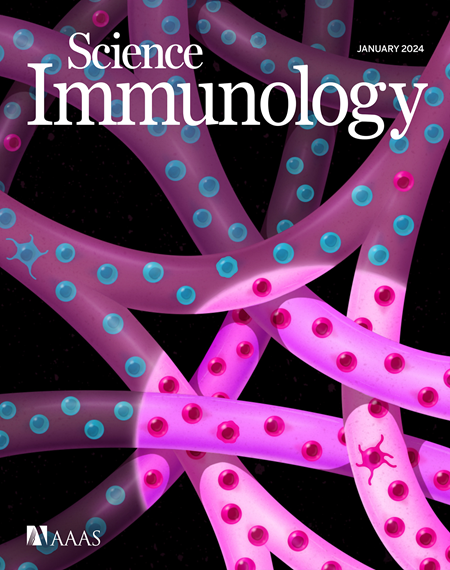一种蠕虫酶通过表观遗传靶向前列腺素合成来破坏巨噬细胞介导的免疫
IF 17.6
1区 医学
Q1 IMMUNOLOGY
引用次数: 0
摘要
蠕虫寄生虫逃避宿主免疫的分子机制尚不完全清楚。在使用多回Heligmosomoides polygyrus bakeri (Hpb)的肠道蠕虫感染小鼠模型中,我们发现蠕虫谷氨酸脱氢酶(heGDH)通过抑制巨噬细胞介导的宿主防御来驱动寄生虫的慢性性。结合RNA-seq, ChIP-seq和靶向脂质组学,我们发现前列腺素e2 (pge2)是heGDH的主要免疫调节机制。heGDH诱导pge2和其他免疫调节因子,包括IL-12家族细胞因子和吲哚胺2,3-双加氧酶1,需要p300介导的组蛋白乙酰化,而该酶的催化活性抑制巨噬细胞通过2-羟基戊二酸合成促2型白三烯。相比之下,免疫调节因子的诱导涉及heGDH N端,通过潜在地介导与蛋白质组学鉴定的细胞靶标(CD64和GPNMB)的相互作用。2型细胞因子抵消了heGDH对宿主防御的抑制作用,表明2型免疫可以限制蠕虫驱动的免疫逃避。因此,蠕虫利用一种无处不在的代谢酶来表观遗传地靶向2型巨噬细胞的激活并建立慢性。本文章由计算机程序翻译,如有差异,请以英文原文为准。
A helminth enzyme subverts macrophage-mediated immunity by epigenetic targeting of prostaglandin synthesis
The molecular mechanisms by which worm parasites evade host immunity are incompletely understood. In a mouse model of intestinal helminth infection using Heligmosomoides polygyrus bakeri (Hpb), we show that helminthic glutamate dehydrogenase (heGDH) drives parasite chronicity by suppressing macrophage-mediated host defense. Combining RNA-seq, ChIP-seq, and targeted lipidomics, we identify prostaglandin E2 (PGE2) as a major immune regulatory mechanism of heGDH. The induction of PGE2 and other immunoregulatory factors, including IL-12 family cytokines and indoleamine 2,3-dioxygenase 1, by heGDH required p300-mediated histone acetylation, whereas the enzyme’s catalytic activity suppressed the synthesis of type 2–promoting leukotrienes by macrophages via 2-hydroxyglutarate. By contrast, the induction of immunoregulatory factors involved the heGDH N terminus by potentially mediating interactions with cellular targets (CD64 and GPNMB) identified by proteomics. Type 2 cytokines counteracted suppressive effects of heGDH on host defense, indicating that type 2 immunity can limit helminth-driven immune evasion. Thus, helminths harness a ubiquitous metabolic enzyme to epigenetically target type 2 macrophage activation and establish chronicity.
求助全文
通过发布文献求助,成功后即可免费获取论文全文。
去求助
来源期刊

Science Immunology
Immunology and Microbiology-Immunology
CiteScore
32.90
自引率
2.00%
发文量
183
期刊介绍:
Science Immunology is a peer-reviewed journal that publishes original research articles in the field of immunology. The journal encourages the submission of research findings from all areas of immunology, including studies on innate and adaptive immunity, immune cell development and differentiation, immunogenomics, systems immunology, structural immunology, antigen presentation, immunometabolism, and mucosal immunology. Additionally, the journal covers research on immune contributions to health and disease, such as host defense, inflammation, cancer immunology, autoimmunity, allergy, transplantation, and immunodeficiency. Science Immunology maintains the same high-quality standard as other journals in the Science family and aims to facilitate understanding of the immune system by showcasing innovative advances in immunology research from all organisms and model systems, including humans.
 求助内容:
求助内容: 应助结果提醒方式:
应助结果提醒方式:


